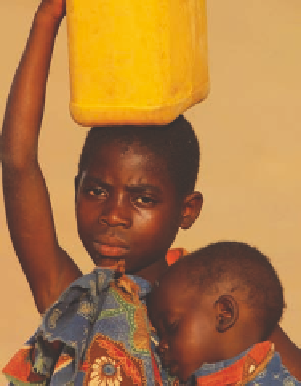Environmental Engineering Reference
In-Depth Information
Europe
North
America
Asia
Africa
South
America
Australia
Stress
High
None
Figure 11-6
Natural capital degradation:
stress on the world's major river basins, based on a comparison of
the amount of water available with the amount used by humans. (Data from World Commission on Water Use in
the 21st Century)
Poverty also governs access to water. Even when a
plentiful supply of water exists, most of the world's 1.1
billion poor people living on less than $1 (U.S.) per day
cannot afford a safe supply of drinking water and so
live in
hydrological poverty.
Most are cut off from munic-
ipal water supplies and must collect water from unsafe
sources or buy water—often taken from polluted
rivers—from private vendors at high prices. In water-
short rural areas in developing countries, many
women and children must walk long distances each
day, carrying heavy jars or cans, to get a meager and
sometimes contaminated supply of water (Figure 11-7).
hiring private companies to manage them. In addition,
three large European companies—Vivendi, Suez, and
RWE—have a long-range strategy to buy up as much
of the world's water supplies as possible, especially in
Europe and North America.
Currently, 85% of Americans get their water from
publicly owned utilities. This may soon change.
Within 10 years the three European-based water com-
panies aim to control 70% of the water supply in the
Politics and Ethics Case Study: Who Should
Own and Manage Freshwater Resources?
Controversy exists regarding whether water supplies
should be owned and managed by governments or by
private corporations.
Most people believe that everyone should have access
to clean water. But who will pay for making this water
available to everyone?
Most water resources are owned by governments
and managed as publicly owned resources for their cit-
izens. An increasing number of governments are re-
taining ownership of these public resources but are
Figure 11-7
Global
outlook:
villager in
Mozambique, Africa,
carrying water and
an infant.





